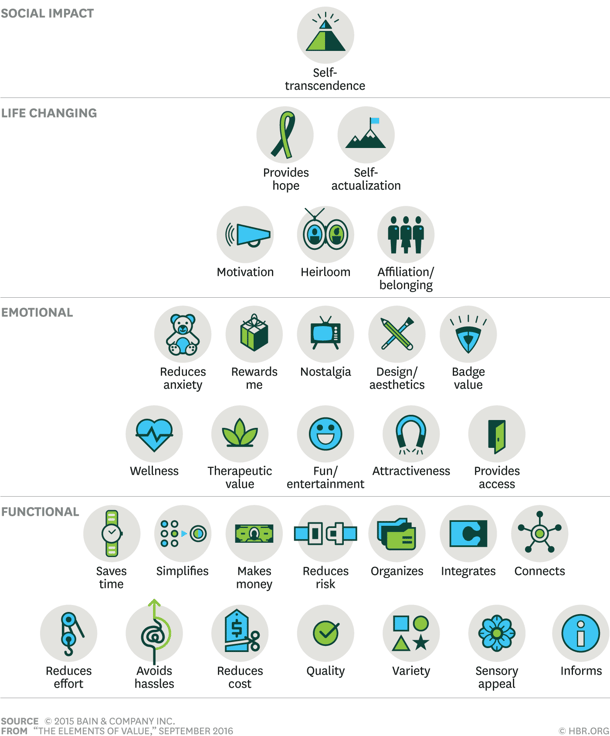The 30 Elements of Value Pyramid (A Model By Bain & Company)
Products and services deliver fundamental elements of value. Increasing value occurs when a company’s leadership team recognise the elements of value as a growth opportunity. It is fascinating to think about how your offering stacks up against the pyramid!
Flicking through the September issue of the Harvard Business Review, I arrived at a page with an attractive model resembling Maslow’s hierarchy of needs. Produced by Bain & Company
I’ve written several articles about Maslow’s hierarchy, and have spent 2 years on a book deconstructing a variety of business models and frameworks, so naturally I was intrigued by this new variant. Where Maslow’s hierarchy applies to human motivation at a very broad level, this model highlights the fundamental elements involved in product/service value.
The Elements of Value Pyramid
Products and services deliver fundamental elements of value that address four kinds of needs: functional, emotional, life changing and social impact. In general, the more elements provided, the greater customers' loyalty and the higher the company's sustained revenue growth.

Unlike the many questionable graphics you see posted on social media every day with “the key elements of [insert topic],” this model is grounded in evidence. Bain worked with a data collection company to survey over 10,000 consumers’ perceptions of over 50 U.S.-based companies. The researchers probed consumers’ statements, honing in on the fundamental attributes that drive purchasing decisions, eventually settling on 30 elements. According to the Bain researchers, strong performance on multiple elements correlates closely with revenue growth.
In general, the elements are arranged in a hierarchical way that reflects Maslow’s basic needs (the more meaningful elements of value are at the top) and the more elements that a company is able to master, the greater the returns in customer loyalty and advocacy. Companies with high scores (8/10 or higher) on 4 elements had an average of 3 times more customer advocacy than companies with only one high score on a given element—and 20 times higher advocacy than companies with no high scores. Interestingly, quality is the element that impacts customer advocacy more than any other element across all industries studied.
Of course, it’s not going to be feasible for every company to capture every element, and attempting to implement such a strategy could do more harm than good. It’s important to focus on the right elements at the right time, according to your unique situation.
My first impression of the model was very positive overall, and I could easily see this becoming an indispensable tool for marketers, included in textbooks next to classics like the 4 P's of marketing, AIDA, the 6 principles of influence, and the diffusion of innovations curve. And even though the expressed intent is around driving customer loyalty, I could also see this model as having room for inclusion in conversations around topics such as employee engagement, rewards, culture, and retention.
The Bain researchers note that their value pyramid is a heuristic model—more practical than theoretically perfect. As Maslow acknowledged over 50 years ago, the level of individual variance in human psychology makes virtually any new model introduced in this field immediately vulnerable and an easy target for criticism. Far from thinking his model was perfect, Maslow recognised several flaws within his motivation theory; however, the whole point behind his proposal was to move the conversation forward by offering a model that, he hoped, would stimulate new ideas and debate. It’s also important to note that models generally have a context that is much broader than what you see expressed visually in terms of words, numbers, boxes, and graphic elements. I recommend reading the original article that describes the research on this new model in more depth to get a more complete understanding of the framework as a whole, as well as each individual element.
See the full article in the Harvard Business Review.

Theo Winter
Client Services Manager, Writer & Researcher. Theo is one of the youngest professionals in the world to earn an accreditation in TTI Success Insight's suite of psychometric assessments. For more than a decade, he worked with hundreds of HR, L&D and OD professionals and consultants to improve engagement, performance and emotional intelligence of leaders and their teams. He authored the book "40 Must-Know Business Models for People Leaders."

/Maslows%20Hierarchy_%206%20myths.png?width=374&name=Maslows%20Hierarchy_%206%20myths.png)
/The%20Hidden%20Power%20of%20Empathy%20in%20Leadership%20During%20Business%20Challenges.png?width=374&name=The%20Hidden%20Power%20of%20Empathy%20in%20Leadership%20During%20Business%20Challenges.png)
We Would Like to Hear From You (0 Comments)